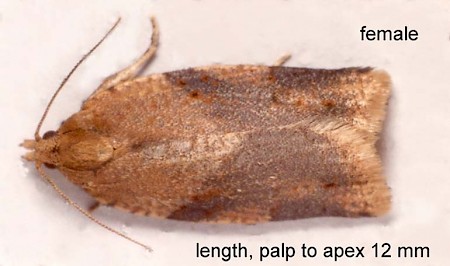Cyclamen Tortrix Clepsis spectrana

49.037 BF993
Cyclamen Tortrix Clepsis spectrana
(Treitschke, 1830)
Wingspan 16-22 mm.
This is a very variable species. The ground colour of the forewing ranges from creamy yellow to rich chestnut-brown or dark brown. However, it usually shows a similar pattern of darker markings.
The costa of the male's wing is distinctly convex, while on the female the distal half of the costa is slightly concave.
It flies between early May and September, but is commonest in mid June. It occurs in a variety of habitats, but prefers lush vegetation in damp conditions, including wet woodland, marshes, bogs and coastal saltings. It is common over England, Wales, Ireland and southern Scotland.
The larvae feed in the spun leaves and flowers of a wide variety of herbaceous plants, including Great willowherb (Epilobium hirsutum), meadowsweet (Filipendula), cinquefoils (Potentilla), Yellow flag (Iris), nettles (Urtica), honeysuckle (Lonicera), and cultivated plants such as cyclamen, strawberry, hops, Pelargonium and brideworts (Spiraea). On saltings, Sea aster (Aster tripolium), sea-wormwood (Artemesia maritima), Common sea-lavender (Limonium vulgare) and other maritime plants are eaten. It has been occasionally found on trees; oak (Quercus), maples (Acer), poplar (Populus) and spruce (Picea).
Full-grown larvae are most often found in May and June. The body is usually brown or greyish olive, and brownish cream ventrally. The head and prothoracic plate are black or blackish brown. The anal plate is brownish cream with dark brown or blackish marks. There is an anal comb of six to eight prongs. The light brownish cream pinacula serve to separate it from the similar polyphages, Celypha lacunana and Orthotaenia undulana, but rearing is advised for positive identification.

 UKMoths
UKMoths 





